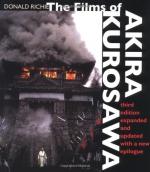|
This section contains 2,019 words (approx. 7 pages at 300 words per page) |

|
SOURCE: "Rashomon: From Akutagawa to Kurosawa," in Literature and Film Quarterly, Vol. 15, No. 3, 1987, pp. 155-58.
[Below, Boyd explores the development of Rashomon from two stories by Akutagawa.]
Kurosawa's Rashomon (or "The Great Rashomon Murder Mystery," as Donald Richie once dubbed it with the director's apparent approval) involves, like more conventional murder mysteries, two distinct narrative lines: the story, or stories, of a crime (the various contradictory accounts of the murder of a samurai and the rape of his wife) and the story of an investigation (the attempt of the characters at the Rashomon gate to sort through these contradictions and determine what really happened). In the case of Rashomon, though, these two narrative lines actually originated in two separate literary sources, and the union of the two, according to Kurosawa himself, was essentially a marriage of convenience:
When I had finished Scandal for the Shochiku studios, Daiei asked...
|
This section contains 2,019 words (approx. 7 pages at 300 words per page) |

|


